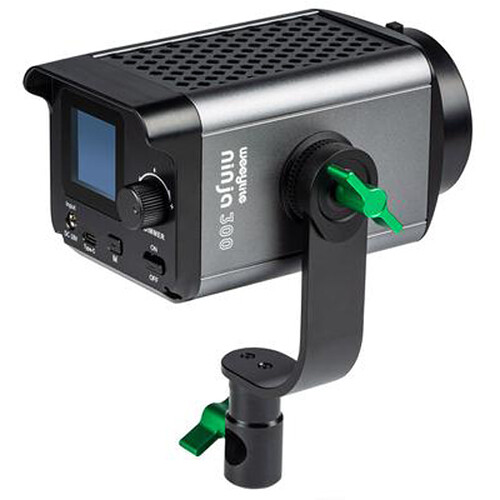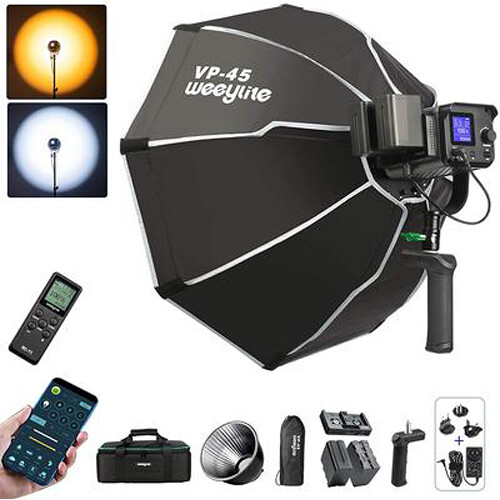Viltrox has released a new single-color LED continuous light under their Weeylite brand. At $179 for the base package, it’s a compelling option. So, is this the end of the strobe? Find out in this exclusive Fstoppers review.
Strobes are the go-to for any photographer working with artificial light, particularly when they are off-site: pre-charge a capacitor in the unit and then pop a short, bright, punch of light onto your subject. Strobes were a solution to the thorny problem of the power-hungry continuous lights used in the video industry. — produce a short burst of light to achieve the same type of illumination. However, that’s the nub of the problem: it’s a flash. There are two serious side effects to the strobe. Firstly, you don’t get to see what the illumination is like until after the fact. Imagine what this was like when shooting film. There was no real way to check until you get your processed negatives back and hope you were technically brilliant. Digital has significantly lessened that problem, but even so, it can lead to excessive chimping at the screen. Secondly, the focal plane shutter on a camera means that the fastest shutter speed you can use is up to around 1/250 s, which isn’t very fast if you want to start using strobes in sunlight. High-speed sync is one solution to this problem, but it reduces the intensity of flash and kills the battery more quickly.
Enter the humble LED, which is massively more energy efficient; in an instant, the world of lighting was turned upside down with the continuous light now back in the frame. Not only could you now generate reasonable quantities of light in a small, low-power package, but there were the added benefits of seeing your lighting in real-time, easily shooting on-site video, having access to full RGB colors, having a range of continuous lighting effects (e.g. a crackling fire), and no specific need for wireless triggers. LEDs are no panacea, as they aren’t as powerful as strobes and the battery life is shorter (because you are continuously lighting a scene), but the upsides are big.
Weeylite Ninja 300
Viltrox has been making optical accessories since 2009, selling lenses, video monitors, and LEDs among other things. What makes Viltrox stand out from the crowd has been its ability to produce low-cost products manufactured in China, designed and built to good quality. It has been able to leverage manufacturing in a low-cost country, with standardized designs selling in large volumes. The Weeylite brand was introduced in 2019 for its newer ranges of LED lights, even though they sold some under the Viltrox brand previously.
So, what is available under the Weeylite offering? Crucial to the current range is understanding the type of LEDs now in use. If you remember LEDs coming out, then you might be thinking of lots of small bulbs attached to a plane on a large panel. However, the current generation of LEDs is called Chip-on-Board or COBs, mounting the LED chip directly onto the substrate to produce arrays with significantly higher densities than in the past. In short, brighter, smaller lights mean better power consumption.
There are currently three monoblock-looking Ninja lights, the 200, 300, and 400. It was the Ninja 300 that I was sent for review and is available at B&H. This is a single color (5,700 K) light with an 80 W power output. The 200 is an 80 W bi-color model, while the 400 is a 150 W bi-color. The Ninja 300 is therefore the lowest-priced product for shooters that don’t need color. At 175x92x85 mm in size, weighing in at 1 kg, it is relatively portable. Made from aviation aluminum and high-quality plastics, it feels reassuringly well built. The 5,700 K light should be accurate with CRI and TLC scores both over 95. The light can be controlled via a Bluetooth app (for Android and iOS), which is simple to use and works well; don’t forget to turn on location services or it won’t work. You can put lights into different groups and channels, much like you would with a strobe, and then control them directly from the app. This is perhaps the biggest use for the Ninja 300; as a stills photographer, I’m not interested in the flashing models (of which there are 12), so the only other thing to control is the brightness. There is a simple gimbal mount that allows you to clamp the vertical rotation and affix it to a light stand. The setup is completed with a 5.5″ aluminum silver lampshade.
 The back panel is pretty simple: a 1.5″ diagonal OLCD screen, DC-in socket, USB-C (for firmware upgrades), mode switch, power switch, and dimmer switch. There is a relatively small external power supply that can drive the unit. It’s worth noting that the yellow array on the front — which looks like a light socket — is the COB array. Unlike my “don’t-really-read-the-manual” approach, take the protective plastic cover off, as the array gets very hot. As I now know, it can melt carpet! And don’t look at it, as it’s very bright. This brings home one of the less pleasant aspects of continuous light: if you’ve ever been in front of the camera, then you will know how hot and bright it gets. While the photographer might like the WYSIWYG feel of LEDs, it can be less pleasant for the talent.
The back panel is pretty simple: a 1.5″ diagonal OLCD screen, DC-in socket, USB-C (for firmware upgrades), mode switch, power switch, and dimmer switch. There is a relatively small external power supply that can drive the unit. It’s worth noting that the yellow array on the front — which looks like a light socket — is the COB array. Unlike my “don’t-really-read-the-manual” approach, take the protective plastic cover off, as the array gets very hot. As I now know, it can melt carpet! And don’t look at it, as it’s very bright. This brings home one of the less pleasant aspects of continuous light: if you’ve ever been in front of the camera, then you will know how hot and bright it gets. While the photographer might like the WYSIWYG feel of LEDs, it can be less pleasant for the talent.
For a little bit extra cash ($229), the full kit comes with a carry case, softbox, battery holder, two batteries, remote control, and pistol grip. If you need to shoot out and about, then the battery power is fantastic (see the image gallery below). A base plate screws to the side of the light, with a cable that runs to the DC-in on the back. There is an IN/OUT switch on the base plate which allows you to flick between charging the batteries (via a USB-C cable) and powering the light. The batteries are the standard NP-F550 and easy to get ahold of. There is also a surprisingly useful pistol grip; if you’ve got an assistant (or long arms), then you can run and gun easily; however, it is surprisingly heavy after a while!

With the lampshade attached, the light gave a bright, fairly even spread with even dimming at the edges. The relatively small softbox attaches to the mount on the front of the head and comes with a diffusion panel as well as a grid. There is an additional Bowens mount, which sadly doesn’t come as part of the kit and can’t be ordered separately from Viltrox (and only part of a kit) but should be available from third-party sellers. It’s worth noting that there is a fan, and while it’s not overly noisy, it’s not exactly quiet either. If you’re shooting video, then you might want to test whether this is audible; the light options do allow you to turn the fan off (although the light will then get hotter).
What I Liked
If you’ve never shot with an LED before, then the flexibility that continuous light offers you is fantastic — no camera chimping, just adjust and go. It’s great for on-site work and makes it much faster to run and gun. Beyond being an LED, it is also incredibly well priced. The basic light gets you up and running, but the kit offers you a full package to cover all eventualities, particularly if you need to use it battery-powered. The new COB design means it is surprisingly bright and useful both in-studio and outdoors.
What Could Be Improved
Upfront, this isn’t as powerful as some of my strobes, and I found in very bright sun that I would switch to those, using HSS. It’s also not as portable as a strobe, which may be an issue for some shooters. The external battery pack makes the unit smaller but feels just a little homebrew, although other manufacturers do the same. It would be nice if there were an internal battery compartment. It’s also monochrome. If you want to take advantage of color adjustment (and so avoid the need to use gels), then go for the Ninja 200 at the slightly higher price of $240.
Conclusion
From the above, you can probably tell that I enjoyed shooting with this light. It’s very keenly priced, great in the studio or on location, and crucially offers that LED continuous light. Getting to see what you are shooting in real-time is fantastic. The kit is very flexible, allowing you to use it in a range of situations, and is also pretty portable. In short, if you need the first LED, this is a great option. Is the strobe dead? Maybe not yet, but it could well be the beginning of the end. You can order yours here.